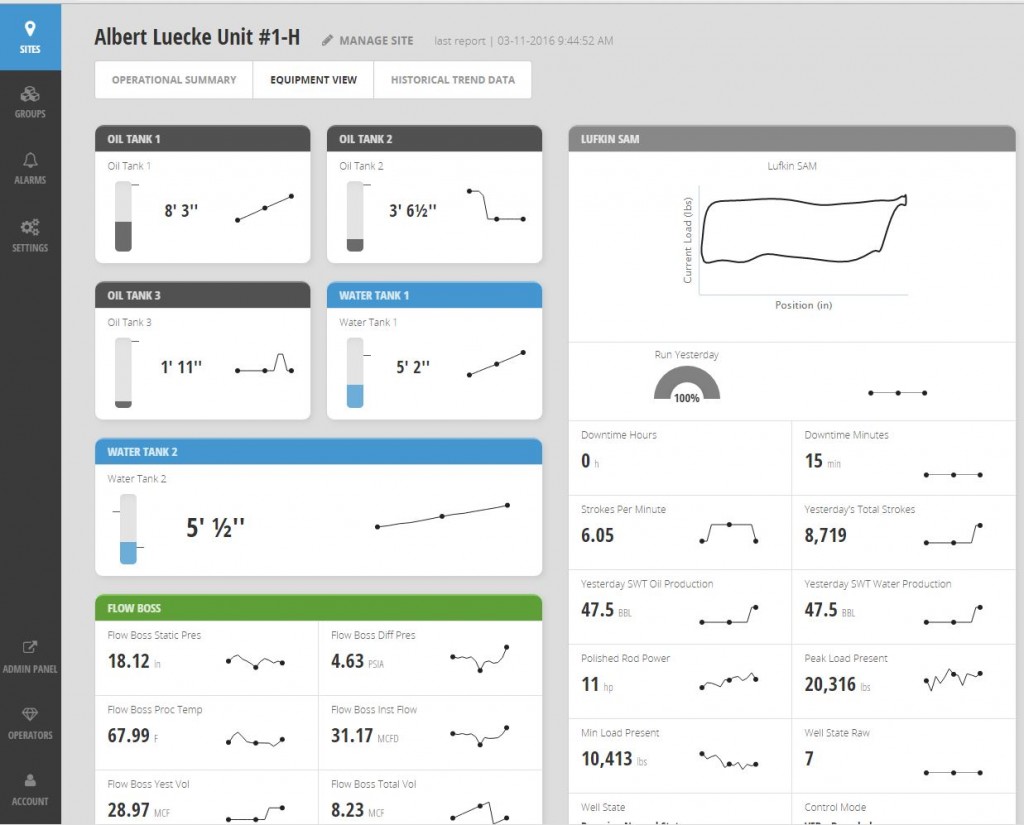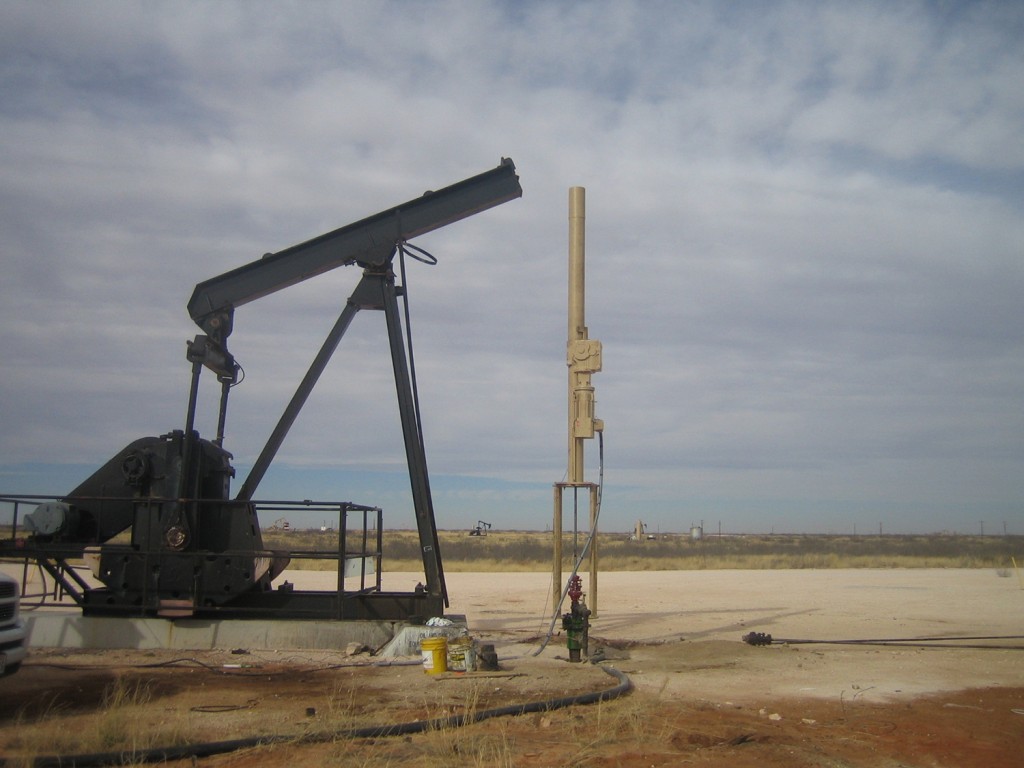by Paul Wiseman
The integration of man and machine has fired the imaginations of science fiction writers for over a century, promoting both wonder and fear. Now, automation is changing the landscape of the oilfield, allowing the click of a mouse or a thumb on a touchscreen to start or stop pumps, sort data, and greatly reduce the human trips to a remote well site. Electronic eyes watch those distant pads for leaks, encroachments, and other things labeled “exceptions.” Systems as a whole deliver so much information it must be addressed by a new phrase: Big Data.
Monta Sewell wears many hats, including that of vice president of Atoka Operating. For approximately 10 years, he has depended on remote cameras and pressure and tank-level monitors for peace of mind, referring to it as an insurance policy against any number of surprises on both business and personal properties.
“Like on my ranch, I don’t want to worry about a salt water leak,” or a leak on anyone else’s property, he said. Professionally, he can monitor wells for high or low discharge pressure and tank levels on high-volume wells. “When the tanks reach a certain level, it turns those high-volume wells off so I don’t have to worry about tanks running over and that kind of thing,” he said.
It also allows for monitoring the activity of authorized visitors such as water haulers and oil transport trucks just to make sure everything is going as expected.
Constant remote-monitoring removes the possibility of a pumper visiting a site and leaving five minutes before a problem occurs, leaving it untended until the next trip in 24 hours or more.
Mike Swihart, president of Production Lift Technologies, Inc., uses the insurance policy concept to push production in wells using plunger lift for production.
With the ability to “get some eyes on wells,” in his terminology, “now we can do what we’d like to do. We’d like to push these wells a little bit, see how much we can get out of them.” When the only eyes on a well are those in person, producers must keep everything within the safest parameters possible because of the previously mentioned scenario where personnel drives off and gets no data from the well for 24 hours or more.
Plunger lift technology relies on downhole pressure to allow the well to produce itself, and Swihart noted that this involves a delicate engineering balance that, without monitoring, had to be very conservative so that it did not lock up the well. Plunger Lift technicians were very good at this, realizing that more aggressive settings could bring more production if they were monitored.
“With automation,” Swihart said, “you can take the risk, you’re not so reluctant to push it.” By being able to monitor the well even as the technician drives off, any negative result can be corrected very quickly.
The 24/7 monitoring ability also reduces operating costs, in Swihart’s estimation, because personnel, in most cases, only go to problem wells instead of putting in windshield time to inspect a well that may be running smoothly. By setting up alarms when any reading gets outside its parameters, personnel can address problems any hour of the day or night.
Improvements in price and reliability—the same curve that applies to all electronics—have made automation an obvious choice in Swihart’s view, especially when producers must cut expenses wherever they can.
Because automation is more about technology in general than the oilfield specifically, Swihart decided to do his PLTI hiring from the electronics field and train them in what they needed to know about the oilfield rather than the other way around. Much of the technology is useful in any kind of industrial application, including manufacturing, refining, and more, so a deep background in oil was deemed less important than the knowledge of electronics and monitoring.
Instead of sending technicians to the field in the seemingly requisite pickup trucks and having them try to service tiny electronics parts with one leg propped up on the back bumper, Swihart invested in panel vans and equipped each one with a workbench and a fully supplied shop with parts and tools. The arrival of a PLTI van on a well site does bring about the occasional raised eyebrow, but Swihart says it makes his people much more efficient.
For customers that need it, PLTI can monitor the wells for them, sending an alarm for any exceptions to the preset parameters. From there, the decision is made as to whether PLTI or the client goes to the well site.
Explosive growth in what is known as I & T, or instrumentation and technology, caused Odessa College to begin offering an associate’s degree in I & T in 2011. A half-million-dollar grant from Chevron and other sizeable gifts from the oil industry have allowed the college to buy state-of-the-art equipment for training purposes.
Department Chair Danny Bailey reports that the college’s enrollment always goes down during a boom and back up during a bust and this cycle is no exception. Five years ago, the enrollment in his program was about 110. Now it’s upwards of 250, with 80 percent of the students attending night classes because they are currently employed. Bailey said most of the evening attendees have been promised some combination of a raise or promotion upon completion of the degree, with companies reimbursing most or all of the cost. Daytime students are either recent high school graduates or have lost oilfield jobs and are retraining for a more in-demand position.
“Many of them are being asked to do more, so they come here for training,” added Associate Professor James Robles.
For example, said Bailey, a company electrician will go to a recently completed well to run power to the pump and other equipment, but the company also wants him to install automation equipment so they do not need to send another person to do that. So they send the electrician to OC to add automation to the person’s skill set.
One recent student who had lost a job took classes while sleeping in his car at night.
Because automation programs also apply to other industries, the OC program includes training in how to program manufacturing equipment as well as the automation itself.
Even with retraining, automation may foment a net loss in employment. Program Instructor Pete Barreraz, who came to OC after retiring from a cement plant, noted that the plant employed 140 people when he started and, as a result of automating so many processes, had only 60 when he retired 27-and-a-half years later.
Many local companies in and out of the oil sector look to hire from the program. The OC faculty listed Oxy, Luminant, Oncor, ConocoPhillips, and Saulsbury Industries along with Chevron as those who make presentations to students and keep a hand in advising the leaders on what is needed in the field and how to prepare for the future.
For now, the future involves the addition of cameras and sound equipment to come closer to literally having “eyes on the well,” according to Stuart Royal, whose Wellkeeper system Monta Sewell uses. “This comes in a myriad of flavors, all the way from live video monitoring to individual still pictures being taken on predetermined (intervals) or even interactive control where someone can get on a camera and view the facility and take individual pictures.” Installing speakers so the controller can talk and listen to onsite personnel is another feature growing in popularity.
Security in the form of theft prevention has been a motivating factor in the past—and still is—but Royal has seen safety concerns leapfrog into the lead in recent years. “One of my customers at one of the SWDs put cameras in looking for someone who was illegally dumping not just produced water but other types of fluids such as kitchen grease down their saltwater disposal well.” The purpose of the cameras was to identify the culprit and put a stop to the practice.
To the company’s surprise, however, they learned that many vendors and employees were not wearing safety gear, were in unsafe vehicles, and were incurring other safety violations. All violations were on video so employees were basically “caught red-handed” and were retrained. The ongoing benefit is that employees and vendors now know they are being monitored so unsafe behavior has been greatly reduced on an ongoing basis.
Royal noted that the interactive systems with speakers and more features are still on the cutting edge. Most companies are happy with the ability to see who is onsite at any given hour to monitor for safety violations and for theft of equipment or product.
With cameras rolling 24/7 they collect a huge amount of data, so if there is an incident that requires a video review, Royal said there must be video management system software to index and search that data. This is one area where hardware and software work together.
Users can program software to start a camera when a tank alarm is issued so there is a visual record as well as the tank-level information. This also keeps the camera from collecting days of unneeded data to be stored and sorted through later if a tank alarm does happen.
The depth of information involves not just more equipment and software, it also requires more bandwidth for transmission. In previous years, that involved expensive satellite transmission but Royal said the cellular companies have added more and more towers in areas they had previously avoided due to their lack of population. “Now we’re seeing almost all over the oil patch, at least in the Permian, basically covered by at some sort of 3G network, if not 4G. And that makes a big difference.” Microwave and broadband systems are also expanding.
With the great expansion of monitoring capabilities, the question is more and more becoming how to manage and mine this data in order to squeeze every drop and every dime from every well, especially when prices are low. Every procedure will increasingly come under minute inspection as to its efficiency and profitability. How much of this will carry over into the next boom is also something that remains to be seen.
Paul Wiseman is a freelance writer in Midland, Texas.













